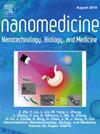金属纳米颗粒在药物传递中的治疗潜力和毒理学挑战:综合综述。
IF 4.6
2区 医学
Q2 MEDICINE, RESEARCH & EXPERIMENTAL
Nanomedicine : nanotechnology, biology, and medicine
Pub Date : 2025-10-09
DOI:10.1016/j.nano.2025.102862
引用次数: 0
摘要
金属纳米颗粒(NPs)已成为先进的药物输送系统,结合了高治疗潜力和复杂的安全性考虑。它们独特的物理化学特性,包括高表面体积比、可调表面和跨越生物屏障的能力,使其在靶向药物输送和治疗方面的应用成为可能。金(Au),银(Ag),氧化铁(Fe₃O₄),氧化锌(ZnO)和铂(Pt) NPs表现出出色的功效:AuNPs达到bbb90 %的药物负载和3-5倍的肿瘤靶向性,AgNPs显示出高达99 %的抗菌活性,Fe₃O₄NPs既可以作为药物载体又可以作为MRI造影剂。然而,毒性仍然是一个主要障碍。报告的挑战包括剂量依赖性细胞毒性(IC₅₀:10-40 μg/mL),肝潴留(30-40 %),氧化应激(2-10倍ROS增加)和免疫激活(高达3倍的细胞因子升高)。安全性由理化性质决定,10期和I期试验的成功率为65- 75% %,明显优于第一代纳米载体。这篇综述强调了纳米技术、毒理学、计算模型和监管框架的多学科整合的必要性。随着不断的创新,金属纳米粒子通过更安全、可扩展和临床可翻译的纳米平台,有望彻底改变精准医疗。本文章由计算机程序翻译,如有差异,请以英文原文为准。
Therapeutic potential and toxicological challenges of metal nanoparticles in drug delivery: A comprehensive review
Metal nanoparticles (NPs) have emerged as advanced drug delivery systems, combining high therapeutic potential with complex safety considerations. Their unique physicochemical features, including high surface-to-volume ratios, tunable surfaces, and the ability to cross biological barriers, enable applications in targeted drug delivery and theranostics. Gold (Au), silver (Ag), iron oxide (Fe₃O₄), zinc oxide (ZnO), and platinum (Pt) NPs demonstrate outstanding efficacy: AuNPs achieve >90 % drug loading and 3–5× improved tumour targeting, AgNPs show up to 99 % antimicrobial activity, and Fe₃O₄ NPs function as both drug carriers and MRI contrast agents. However, toxicity remains a major hurdle. Reported challenges include dose-dependent cytotoxicity (IC₅₀: 10–40 μg/mL), hepatic retention (30–40 %), oxidative stress (2–10× ROS increase), and immune activation (up to 3-fold cytokine elevation). Safety is governed by physicochemical properties, with <10 nm NPs showing efficient penetration but higher genotoxicity, and cationic surfaces being 2–3× more cytotoxic. Several strategies have been developed to overcome these barriers. PEGylation reduces macrophage uptake by 60–75 % and extends circulation time, biodegradable hybrids reduce long-term accumulation by 70–80 %, and controlled-release systems cut doses by 30–50 % without compromising efficacy. Advances in computational tools, such as machine learning (~87 % predictive accuracy), along with standardized testing (<20 % variability), have accelerated preclinical evaluation by 40–50 %. These improvements contribute to therapeutic indices >10 and Phase I trial success rates of 65–75 %, significantly outperforming first-generation nanocarriers. This review highlights the need for multidisciplinary integration of nanotechnology, toxicology, computational modelling, and regulatory frameworks. With continued innovation, metal NPs hold the potential to revolutionize precision medicine through safer, scalable, and clinically translatable nanoplatforms.
求助全文
通过发布文献求助,成功后即可免费获取论文全文。
去求助
来源期刊
CiteScore
11.10
自引率
0.00%
发文量
133
审稿时长
42 days
期刊介绍:
The mission of Nanomedicine: Nanotechnology, Biology, and Medicine (Nanomedicine: NBM) is to promote the emerging interdisciplinary field of nanomedicine.
Nanomedicine: NBM is an international, peer-reviewed journal presenting novel, significant, and interdisciplinary theoretical and experimental results related to nanoscience and nanotechnology in the life and health sciences. Content includes basic, translational, and clinical research addressing diagnosis, treatment, monitoring, prediction, and prevention of diseases.

 求助内容:
求助内容: 应助结果提醒方式:
应助结果提醒方式:


